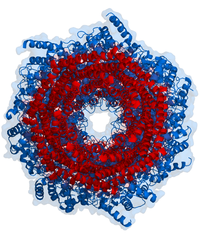
Photo from wikipedia
Dietary protein is necessary throughout all life stages. Adequate intake of protein during juvenile years is essential to enable appropriate synthesis of bone matrix and achieve the full peak bone… Click to show full abstract
Dietary protein is necessary throughout all life stages. Adequate intake of protein during juvenile years is essential to enable appropriate synthesis of bone matrix and achieve the full peak bone mass (PBM). Due to socio-demographic changes, accompanied by environmental damage and ethical problems, a transition to the consumption of different and alternative protein sources in the human diet must occur. This transition requires the precise evaluation of protein quality. Here, we utilize a preclinical model of young rats during their post-natal developmental period to define the nutritive quality of a number of alternative protein sources (soy, spirulina, chickpea, and fly larvae) by their health impact on growth performance and skeletal development. We indicate that when restricted (10% of calories) not one of the tested alternative protein sources have succeeded in causing optimal growth, as compared to the referenced source, casein; yet fly larvae protein followed by chickpea flour were found to be superior to the rest. Growth-plate histology and µ-CT analyses demonstrated a number of changes in growth patterns and bone morphometric parameters. Bone mechanical testing, by three-point bending analyses, was sensitive in demonstrating the effect of the reduction in the amount of the dietary protein. Moreover, the rats’ weight and length, as well as their eating patterns, were found to reflect the proteins’ quality better than their amino acid composition. Hence, our study emphasizes the importance of evaluating protein as a whole food source, and suggests a new approach for this purpose.
Journal Title: Nutrients
Year Published: 2022
Link to full text (if available)
Share on Social Media: Sign Up to like & get
recommendations!